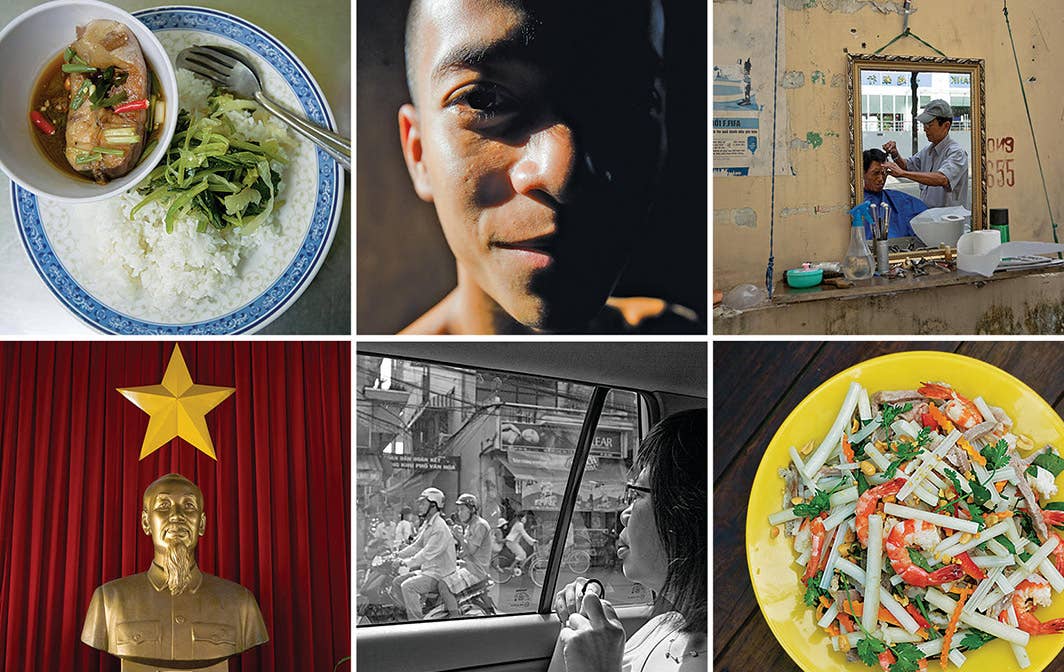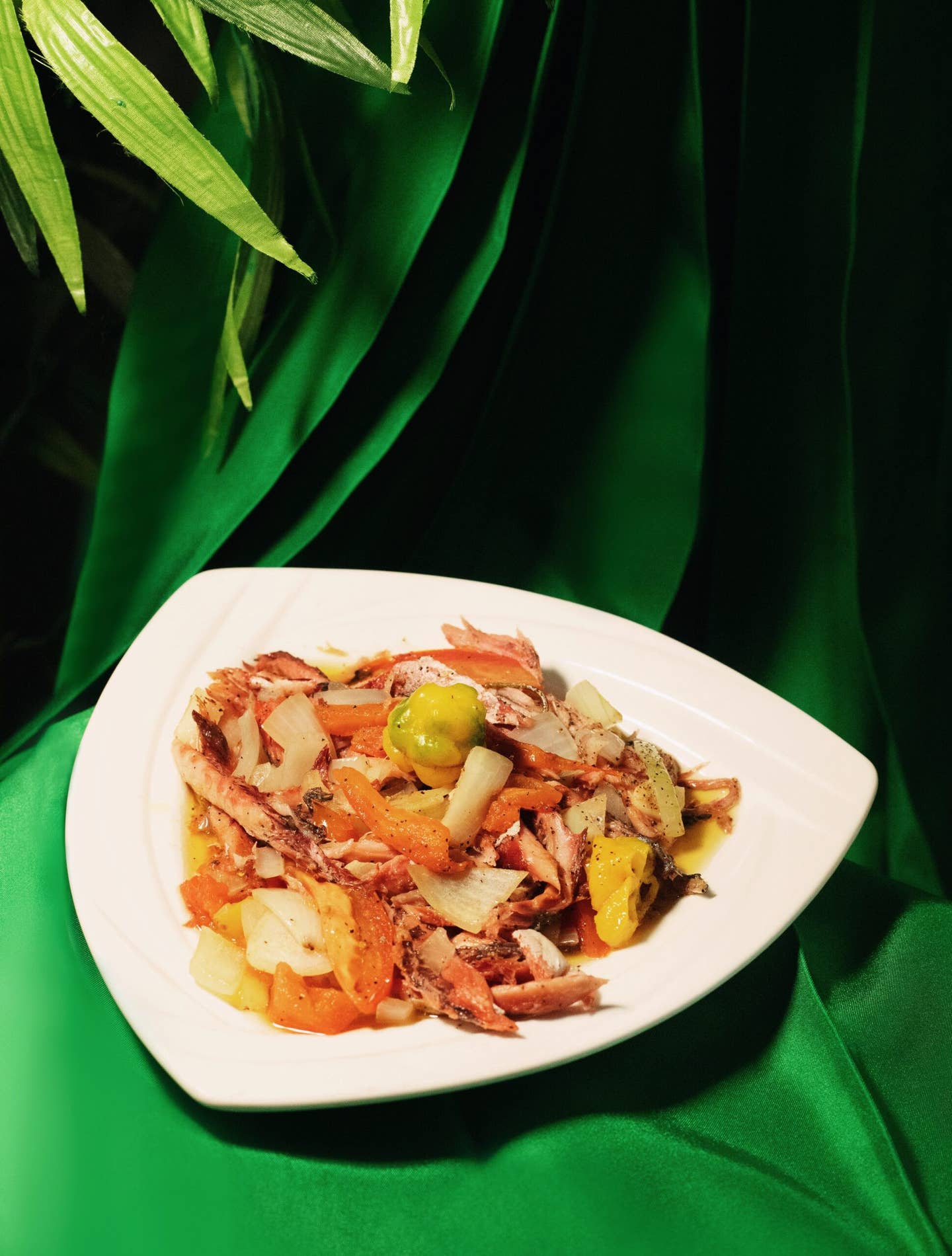
Here we are, my sisters and I, in an air-conditioned cab, driving away from the same airport that my family fought to get into in April 1975, days before North Vietnamese tanks rolled into Saigon. We haven’t been back to the city together since. Yenchi chats with the cabdriver. The oldest of us, she was a teenager when we left Vietnam. She remembers the most and speaks Vietnamese the best. As for me and Tasha, the middle sister, our language skills are frozen at an elementary-school level. My memories of this city are a fever dream.
We’re in the city center now. Amid packs of motorbikes that weave in and out of our path with a strange, fluid serenity, our taxi inches forward, giving us time to see, breathe, almost touch, the street scenes on either side of us. “This is nothing like Little Saigon,” Tasha says, as we pass hawker stalls selling baguette sandwiches and steamed dumplings; I have a picture in my mind of that suburban Vietnamese enclave in Southern California, filled with brightly lit noodle shops and supermarkets, where we shopped and ate when we were growing up. It seems small and far away now. Through the taxi window I see produce stands stocked with vegetables and fruits I’ve not yet tasted; street vendors serving sweet soups made of tapioca, banana, and coconut milk; tiny storefront restaurants packed with diners eating platters of stir-fried crab.
Tasha sees a pile of ripe jackfruit as the taxi crawls past a street stall. “I haven’t had it fresh in years!” she exclaims. “I’ll add it to our list," I promise her. We’ve come to Saigon to eat, and also to remember. They may be the same thing.
It is March, and the heat is crushing. We check in to our hotel and find a cab to take us to the house of Mrs. Nhàn, a friend of our mother’s. Mom used to take us here for bánh cuốn: rolls made of gossamer-thin sheets of rice paper, filled with pork and mushrooms. We’d called ahead, and Mrs. Nhàn is expecting us. “You are family,” she’d said. “Come whenever you like.” A woman in her late 70s or 80s whom I don’t recognize greets us at the door of her tidy storefront restaurant and home; it’s she. We sit on plastic stools. I strain to remember the place but can’t.
Mrs. Nhàn’s daughter-in-law Ngân makes the bành cuốn. Her tools are a ladle, a bamboo stick, and a stockpot of boiling water covered by muslin. She swirls a film of rice-flour batter onto the fabric and lets the batter steam and set. Deftly, she lifts the cooked sheet away with the stick and puts some of the pork-and-mushroom filling into the rice paper. So, I tell myself, this is how you make bành cuốn without a Teflon skillet. Ngân places our bành cuốn, topped with crisp fried shallots, before us. The rolls are chewy and soft, with the delicate sweetness of just-cooked rice. I remember this taste, this texture. I ask Mrs. Nhàn for the batter recipe. “I grind soaked rice, water, and some tapioca starch,” she says. That’s it.
Our first full day in Saigon—now called Ho Chi Minh City, though none of the locals we meet use that name—is disorienting and exhilarating. Everyone looks like us; everyone has hair like ours, eyes like ours. And the food! The tastes and aromas and sights that we used to have to make a side trip for in the States are now everywhere, surrounding us, enveloping us. The flavors are more vivid, the scents more pungent, and yet it is the opposite of exotic. This is just life here. This is Vietnam.
Our lunch is bánh xèo, chewy-crisp rice-flour crêpes filled with pork, shrimp, and bean sprouts and eaten with fresh herbs. The versions of this food I know from America are plate size, but the ones served to us at this bánh xèo shop in the center of town are truly gargantuan and very good; just not what we were expecting.
We have a similar experience at dinner. Tasha declares that she wants the “quintessential Saigon phở experience”, referring to the ubiquitous beef noodle soup. Tasha, a corporate lawyer, does not cook, but she is a passionate and opinionated eater. So we go to Phở Hoà, one of the oldest phở houses in Saigon. The soup that arrives at our table is definitely phở, but it comes with unfamiliar accompaniments: fermented pork sausages called nem, deep-fried Chinese crullers called dầu cháo quầy, and pâtés chauds, savory puff pastries filled with pork. “Why are they serving these things with phở?” Tasha asks. “What do we do with them?” We watch the patrons at the tables next to us; some of them dunk the crullers into their soup; others nibble on the sausage and pastries between spoonfuls. They eat with gusto, with the same practiced movements my parents make when they have phở. We follow suit. The side dishes taste delicious with the star anise-infused broth.
Everywhere we go, cooks are altering, amplifying, dressing up, or dressing down familiar dishes. The city we encounter is obsessed with the new, in a state of constant flux. This is not a bad thing, I tell myself, though it takes me a while to shake a sense of guilt. The trip was my idea, and I’ve led my sisters all this way to taste Vietnamese cooking in its truest form. But then, it’s absurd for me to think that Saigon would wait for us, preserved in amber until we came back.
The next morning, pushing along crowded sidewalks beneath skeins of jury-rigged phone lines, brightly colored awnings, and corrugated-steel eaves, we find our way to our old house, in the Phú Nhuận district. To stand in front of the three-story building feels strange. The house is a preschool now; Disney cartoon characters are painted on the walls of the entrance area. The staff won’t let us in, maybe because they think we’re Việt kiều (Vietnames expatriates) returning to reclaim lost property. Tasha convinces them that we just want to look around for old times’ sake, and they relent. I don’t remember much about the place, though Tasha swears she’s found the spot where the kitchen used to be. Yenchi looks for the tree she used to climb, but it is gone. Her memories flooding back, she leads us around the blocks of our old neighborhood. All the street names have changed.
“Come on,” I say, “we’re going to Phú Nhuận market.” A short walk away we find the open-air bazaar where our mother used to take us shopping. There’s asphalt under our feet now, instead of dirt, but the white noise of haggling shoppers and merchants awakens a vivid memory. The place feels the same: alive, bustling, but not chaotic. Produce vendors pepper us with questions upon learning that we’re Americans who were born nearby: Where was your house? Where do you live now? How old are you? Are you married? How many children do you have? The questions are personal, yet there’s an odd intimacy between us. We may ask you such things, the vendors seem to say, because you are one of us. We, too, are burning with questions. Like all the Vietnamese-Americans I know who have gone back, my sisters and I are burdened by a recurring thought: What would life have been like if we’d stayed? One of the vendors tells us tearfully of the hardships and austerity of the years after the way. She says that times are better now, though, and that Saigon is full of optimism.
My sisters and I split up to visit different parts of the market. Tasha and Yenchi go off to find tropical fruits: pearlike sapodilla, sweet star apple, creamy custard apple, luscious mangoes, fragrant pomelo. I find tiny, pale green hoa thiên lý, delicate flower buds (called Tonkin jasmine) used in soups and stir-fries; before today I’d only read about them in books. After a while I take a seat at a quán bình dân, a workers’ eatery, in the market. I order cá kho, fish steaks cooked in a rich coating of caramel sauce. This version is made in the southern style, with catfish and simmered in coconut water; the cook scatters a handful of scallions and chiles over the fish and serves it to me with tart, clear fish soup and sautéed choy sum greens. The meal makes me feel whole. When I meet up with Tasha and Yenchi again a couple of hours later, they too seem energized. It’s late afternoon, and Tasha is hungry again. I know a place, I say.
The courtyard of Quán Ăn Ngon, the restaurant where we dine, is canopied by tree branches, shaded by canvas umbrellas. At the dge of the courtyard are cooking stations that look like street hawker stalls. We walk from one to the other, look at the offerings, and return to our table to order. The whole, seducing story of Vietnamese cooking is here: the simple, honest flavors of the country’s north; the gutsy, earthy soups and dainty court delicacies of Huế, the old imperial capital; the voluptuous, multilayered dishes and fresh seafood of the south. We cover our table with food: the southern favorite chao tôm, grilled ground shrimp on sugarcane stalks; spicy bún bò huế, the famous beef and pork noodle soup from Huế; and ốc nhồi, steamed stuffed snails with lemongrass, from the north.
On our last night we return to Mrs. Nhàn’s home. She and Ngân have cooked a farewell dinner for us. There is giò heo hầm măng, rich pork hocks stewed with bamboo shoots, and gỏi ngó sen, a southern salad of crisp lotus stems, shrimp, pork, Vietnamese coriander, and a fragrant celery called rau cần. I have only used jarred lotus stems in the United States, so Ngân gives me a lesson on splitting and washing fresh ones. We pull the dining table to the center of the room, open the front door, and sit down to eat. A warm evening breeze washes over us. Motorbikes buzz by outside. We fill our plates. Tasha takes a bite of the gỏi ngó sen. “I remember this!” she says. I try some too, and the flavors, so clean and bright, cut through the fog of the years.
Keep Reading
Continue to Next Story










